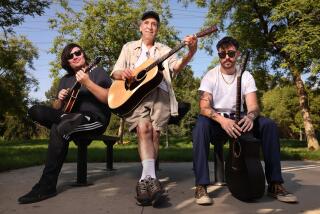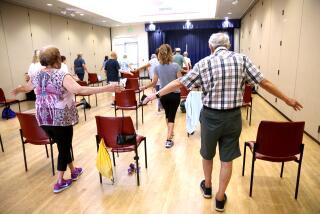Offering Tenderness to Elderly Is Child’s Play--and Vice Versa : Trends: Nurse who runs home for the elderly and day-care center for youngsters says her charges help each other. “The old ones need to love somebody, and the young ones need to be loved.”
OTHELLO, Wash. — Peggy Klingeman is on a mission of love, bringing together the old and the young to fulfill each others’ need for affection.
She emphasizes interaction between the six elderly people who live at her home and the 18 or so children enrolled in day care there.
“They’re at the opposite ends of life and feel most the effects of neglect,” Klingeman said. “Who has time these days to take care of the old ones and the young ones? The old ones need to love somebody, and the young ones need to be loved. They just fit together hand in hand, like a ball and a glove.”
Programs like Klingeman’s Country Care in Othello in rural eastern Washington are popping up around the country as people realize that the needs of the old and young are very similar, said Donna Couper, executive director of Center for Understanding Aging.
The center is a nonprofit organization based in Southington, Conn., that promotes intergenerational programs and specializes in promoting education on aging.
“We live in a society that is increasingly alienated,” Couper said. “I see this kind of movement as a way to promote human connections. When we don’t have it within our own families, we have institutions that try to come in with substitute connections.”
Both children and the elderly can help each other stay in tune, she said.
“If you’re a younger person, it gives you an understanding that there is life after 16 or 21,” Couper said. “For older people, it’s helping them stay connected when, because of rapid changes around them, they may feel they aren’t as relevant. With all the trends, fads and changing technologies, you can easily feel out of touch.”
John D’Amour, who is responsible for granting licenses to adult family homes for the north-central Washington Department of Social and Health Services, said state officials are pleased with Klingeman’s program.
“She really felt the old people and the young people should be integrated, and all the studies seem to show that’s a valid rationale,” D’Amour said.
He was unaware of any similar facilities in Washington state.
“I think it’s pretty unusual to have it set up like that,” he said.
Klingeman, a licensed practical nurse, said she feared working with the elderly as a student nurse.
“I literally begged them not to make me do an internship in a nursing home,” Klingeman said.
But she learned that working with the elderly could be rewarding and continued doing it. Adams County Counseling Services hired her 18 years ago to develop a geriatrics program at a convalescent center.
“Every week, I took a group of kids to see them,” Klingeman said. “We’d sing and play, and they loved it. We did the same thing every week, and it was like it was brand new each time. I found out that kids, balloons and pets were the key.”
When she opened her day-care center five years later, she continued to make weekly treks to the nursing home. She also began to take care of her ailing grandmother.
Her grandmother ultimately became too sick and went to live in a nursing home. But the experience gave Klingeman the insight and the desire to start her multigenerational care facility.
The children and the older residents have separate buildings, connected by a breezeway. The children aren’t allowed to visit the adult side without permission and supervision by a day-care staffer, and then never more than eight at a time.
A musical kindergarten is held twice a week, where both the children and the adults sing and play games. That program and the daily arts and crafts are optional for the adults.
“Some days, one of the ladies might not feel like participating. But usually they love it,” Klingeman said.
“The main ingredient here is it’s not just the kids,” Klingeman said. “I want to have quality on both sides. The children aren’t allowed in the elderly’s space. They are not allowed to just invade their (the elderly’s) home.”
On a recent afternoon, six of the children came to visit, each running to give a “grandma” a hug. It didn’t matter that two of the women there were visitors who had never met the children; they got hugs too.
They sang songs like “Jesus Loves Me” and silly songs accompanied by hand motions that made old and young alike giggle. They played “London Bridge,” and “Bluebird”--in which a child wove under the clasped hands of the others in a circle until the song ended, at which time the child would choose another to be the bluebird.
After about 20 minutes, the children went back to their area and the elderly women stayed in their chairs, smiling and chatting.
“It all revolves,” Klingeman said. “The elderly person’s behavior goes back to a 2-year-old. A 92-year-old and a 2-year-old are at the same point, they want essentially the same things: care, love and someone to pay attention to them.”
More to Read
Sign up for Essential California
The most important California stories and recommendations in your inbox every morning.
You may occasionally receive promotional content from the Los Angeles Times.










